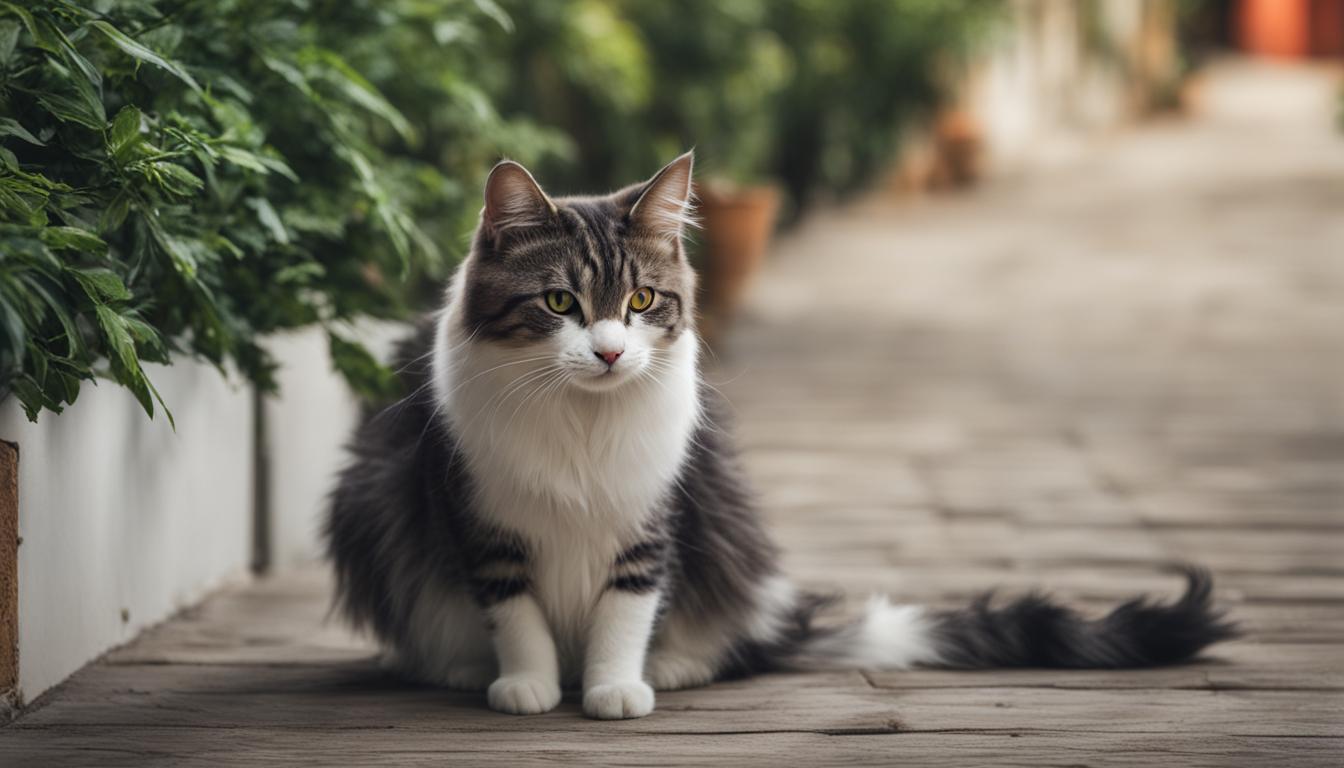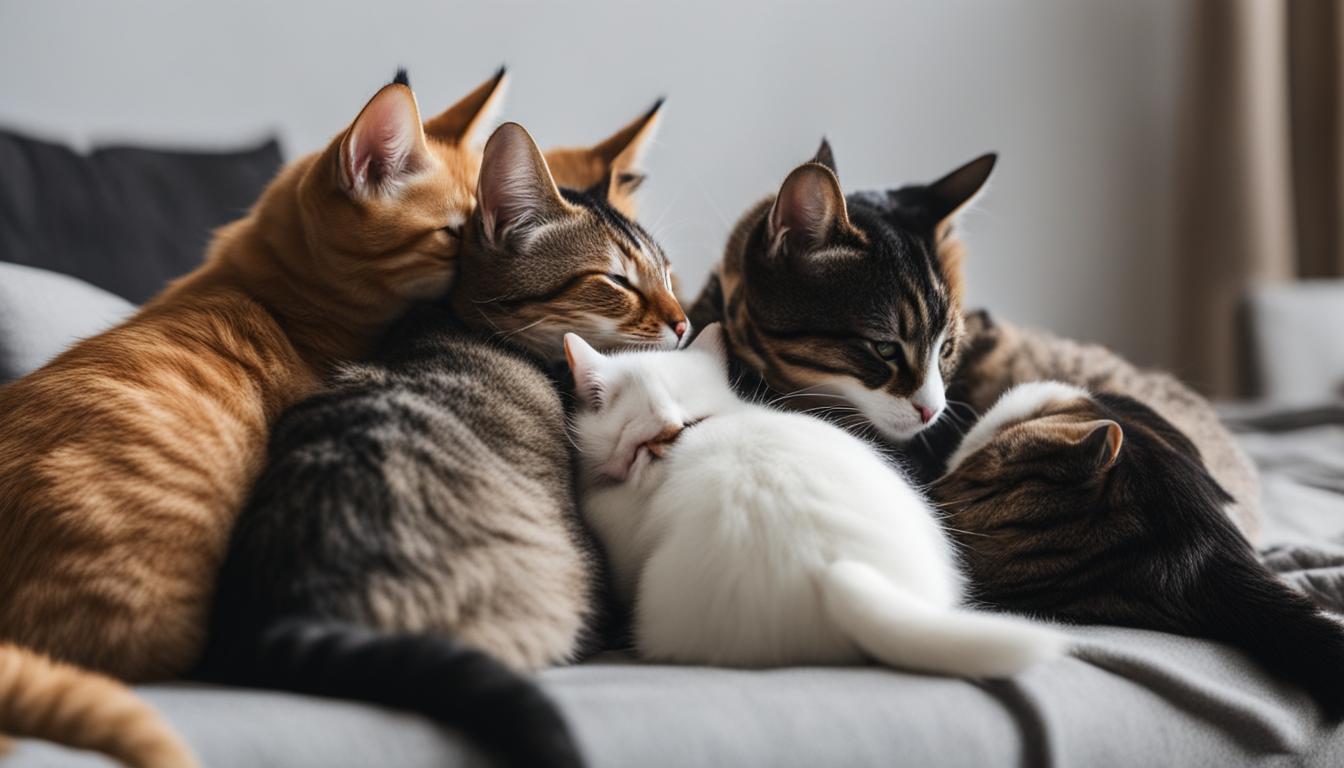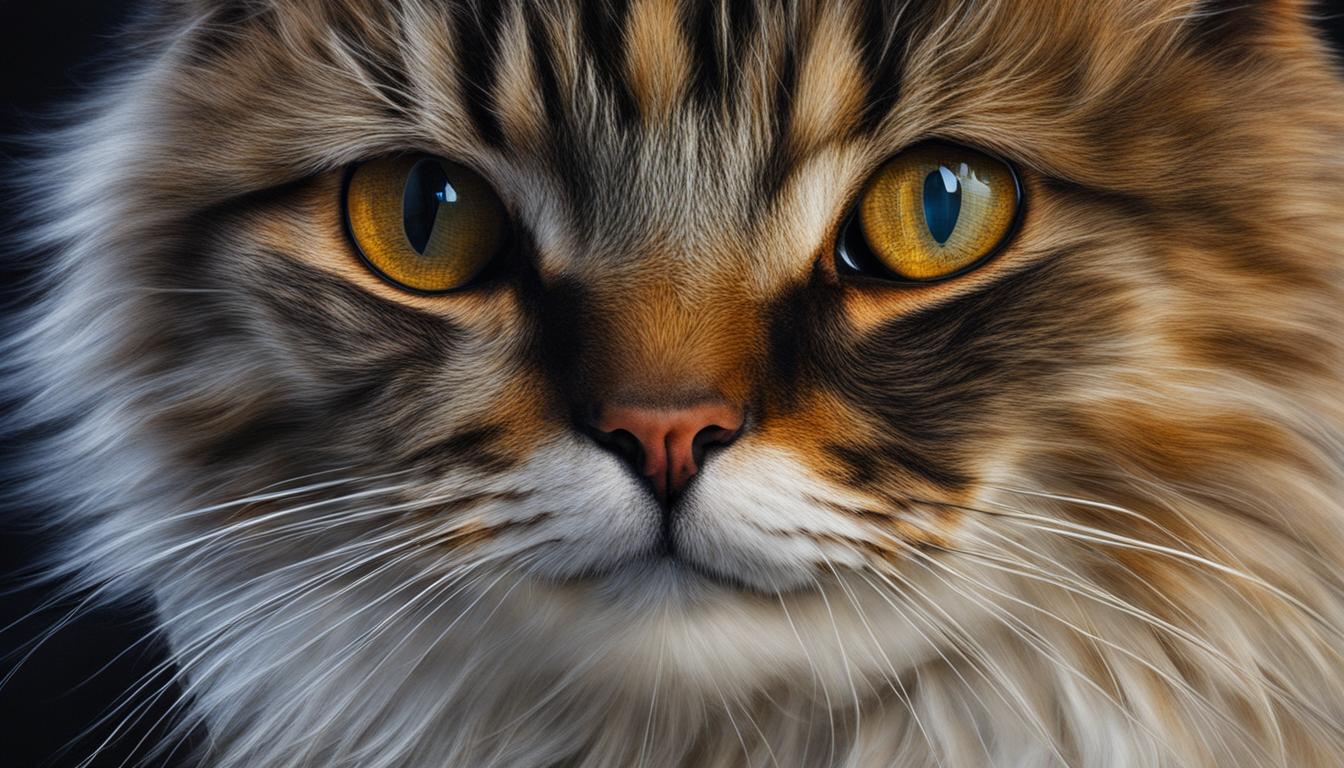As a devoted cat owner, I am always on the lookout for any signs that my furry friend may be in distress. Cats are experts at hiding their illnesses, making it crucial for me to pay close attention to their behavior. Early detection of health issues is key to ensuring that my cat receives the necessary care and attention.
So, what are the behavioral indicators that I should be watching out for? Here are a few early signs of cat illness that every cat owner should know:
Key Takeaways:
- By observing changes in behavior, such as vomiting, diarrhea, and loss of appetite, you can spot potential health issues in your cat.
- Increased thirst, excessive grooming, and aggression can also be indicators of underlying health problems.
- Changes in eating habits, confusion, and alterations in litter box behavior are red flags that should not be ignored.
- Taking prompt action and seeking veterinary care when you notice these behavioral signs is crucial for your cat’s well-being.
- Remember to maintain regular check-ups with your veterinarian to ensure your cat’s overall health.
Recognizing Digestive Problems in Cats
Changes in eating habits can often signal digestive problems in cats. It’s important to pay attention to any alterations in your cat’s appetite as they may be experiencing discomfort or illness. Common changes in eating habits include skipping meals, eating too much, or eating very little. Monitoring these behavioral indicators can help you identify and address digestive issues early on.
Additionally, diarrhea, vomiting, and weight fluctuations are common signs of digestive problems in cats. If you notice any of these symptoms, it’s crucial to seek veterinary attention. Ignoring digestive issues can lead to further complications and discomfort for your furry friend. A veterinarian can diagnose the underlying problem and provide appropriate treatment and dietary recommendations to improve your cat’s digestive health.
To summarize, changes in eating habits, along with symptoms such as diarrhea, vomiting, and weight fluctuations, can indicate digestive problems in cats. Seeking prompt veterinary care is essential to ensure your cat’s well-being. By addressing these issues early on, you can help prevent further complications and discomfort. Remember, a healthy digestive system is vital for your cat’s overall health and happiness.
| Digestive Problems in Cats | Behavioral Indicators |
|---|---|
| Gastrointestinal discomfort | Changes in eating habits: skipping meals, overeating, or eating very little |
| Diarrhea | Loose, watery stool |
| Vomiting | Expelling food or liquid from the stomach through the mouth |
| Weight fluctuations | Unexplained weight gain or loss |
Identifying Respiratory Issues in Cats
When it comes to our feline companions, it’s important to be vigilant and observant of any changes in their behavior. One area of concern is respiratory health. Cats can experience a range of respiratory issues, and it’s crucial to be able to identify the signs early on. Some common behavioral indicators of respiratory problems in cats include wheezing, rapid breathing, shortness of breath, and raspy breathing. These symptoms should never be ignored, as they may be indicative of underlying respiratory diseases such as asthma or upper respiratory infections.
If you notice any abnormal respiratory signs in your cat, it’s essential to seek veterinary care promptly. A veterinarian can thoroughly examine your cat and provide an accurate diagnosis. Treatment options for respiratory issues may include medications to alleviate symptoms, environmental modifications to reduce triggers, or other interventions depending on the specific condition. Early detection and intervention can help alleviate your cat’s discomfort and prevent further complications.
Common Signs of Respiratory Issues in Cats
- Wheezing
- Rapid breathing
- Shortness of breath
- Raspy breathing
By recognizing these signs and seeking timely veterinary care, you can ensure that your cat receives the appropriate treatment and support for their respiratory health. Remember, it’s always better to be safe than sorry when it comes to the well-being of our beloved feline friends.
| Respiratory Symptoms | Possible Causes |
|---|---|
| Wheezing | Upper respiratory infections, asthma |
| Rapid breathing | Stress, anxiety, respiratory diseases |
| Shortness of breath | Heart disease, lung disease |
| Raspy breathing | Inflammation of the airways, infections |
It’s important to note that respiratory issues in cats can range from mild to severe, and professional veterinary guidance is crucial for proper diagnosis and treatment. If you suspect that your cat may be experiencing respiratory problems, don’t hesitate to reach out to your veterinarian and seek their expertise. Remember, your cat relies on you to be their advocate and provide the care they need to live a happy and healthy life.
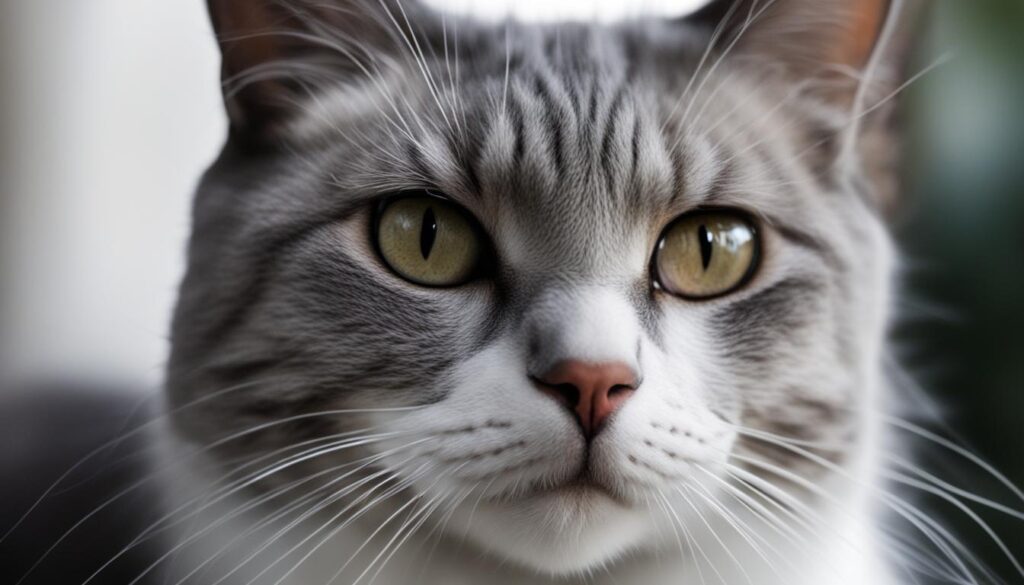
Dental Issues and Behavioral Clues
When it comes to cat health, dental issues are often overlooked but can have a significant impact on your furry friend’s overall well-being. Behavioral changes can be a clue that your cat is experiencing dental problems. It’s essential to pay attention to these signs and take prompt action to ensure your cat’s dental health.
One of the most common behavioral signs of dental issues is bad breath, also known as halitosis. If your cat’s breath has an unpleasant odor, it may indicate dental problems such as tartar buildup, gum disease, tooth infections, or even oral tumors. Excessive drooling and bleeding from the mouth are also important indicators. Additionally, if you notice your cat having difficulty eating or avoiding certain types of food, it could be a sign of dental pain or sensitivity.
Regular dental care is crucial to prevent and address these issues. Professional dental cleanings by a veterinarian can remove tartar and plaque buildup, reducing the risk of gum disease and tooth decay. Brushing your cat’s teeth at home with a cat-specific toothbrush and toothpaste can also help maintain their dental health. Providing dental-friendly treats and toys can contribute to oral hygiene as well. Remember, early detection and treatment of dental problems can prevent discomfort and potential complications for your furry friend.

Table: Common Signs of Cat Dental Issues
| Signs of Cat Dental Issues | Description |
|---|---|
| Bad breath (halitosis) | Unpleasant odor from the mouth |
| Excessive drooling | Abnormal or increased saliva production |
| Bleeding from the mouth | Blood present in or around the mouth |
| Difficulty eating | Avoiding certain foods or struggling to chew |
Behavior-Related Indicators of Pain
As a cat owner, it’s important to be attuned to your feline companion’s well-being. While cats may not express pain as overtly as humans do, they often exhibit subtle behavioral changes when they are experiencing discomfort. One common indicator of pain in cats is increased lethargy. If you notice that your cat is becoming more sedentary and less active than usual, it could be a sign that they are in pain.
Another behavioral clue that your cat may be in pain is aggression. Cats that are experiencing pain may become irritable and exhibit aggressive behavior towards humans or other animals. If your typically friendly and docile cat suddenly starts lashing out, it’s worth considering whether pain could be the underlying cause.
H3: Lethargy and Aggression as Indicators of Pain
In addition to lethargy and aggression, other behavioral changes such as hiding, excessive vocalization, and reluctance to be touched can also indicate that your cat is in pain. Cats may try to conceal their discomfort, so it’s important to pay attention to these behavioral shifts and seek veterinary care if you suspect your cat is in pain. Prompt intervention can help identify the cause of the pain and ensure your furry friend receives appropriate treatment and pain management strategies.
| Behavioral Indicators of Pain in Cats | |
|---|---|
| Increased lethargy | Significantly reduced activity levels |
| Aggression | Uncharacteristic hostility towards humans or other animals |
| Hiding | Seeking seclusion and avoiding social interaction |
| Excessive vocalization | Unusual and persistent meowing or crying |
| Reluctance to be touched | Avoiding physical contact or exhibiting signs of pain when touched |
Remember, cats are masters at concealing pain, so being aware of these behavioral indicators is essential in order to provide the necessary care and support for your feline friend’s well-being. If you suspect your cat may be in pain, consult with a veterinarian who can help determine the underlying cause and develop a tailored plan for pain management.
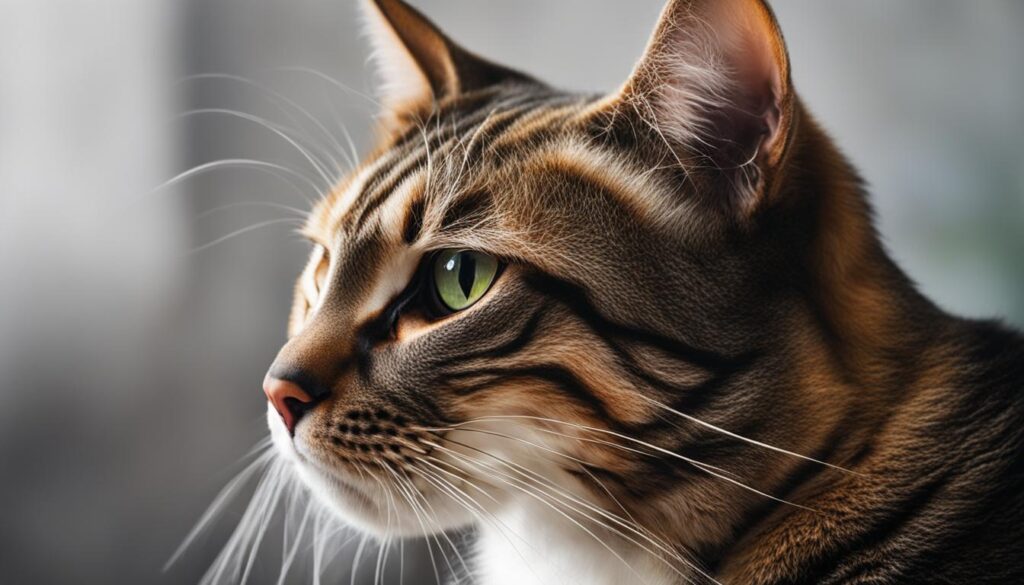
Conclusion
As a cat owner, I’ve learned the importance of being vigilant when it comes to my furry friend’s health. Cats are masters at concealing their illnesses, which is why recognizing behavioral signs of health issues is crucial for early detection and timely veterinary care.
By keeping an eye out for changes in eating habits, such as increased or decreased appetite, along with other behavioral indicators like respiratory symptoms, dental problems, and signs of pain, we can take proactive measures to ensure our cats receive the necessary care and support they need.
Remember, early detection is key. Regular veterinary check-ups and seeking professional advice whenever we notice concerning changes in our cat’s behavior can make a huge difference in their overall well-being. So let’s stay observant, be proactive, and prioritize our feline companion’s health through early detection and prompt veterinary care.
FAQ
What are the behavioral signs of cat health issues?
Common behavioral signs of cat health issues include vomiting, diarrhea, loss of appetite, lethargy, increased thirst, changes in eating habits, excessive grooming, aggression, confusion, and changes in litter box behavior.
What are the signs of digestive problems in cats?
Changes in eating habits, such as skipping meals, eating too much, or eating very little, as well as vomiting, diarrhea, and weight fluctuations can indicate digestive problems in cats.
How can I recognize respiratory issues in cats?
Wheezing, rapid breathing, shortness of breath, and raspy breathing can be signs of respiratory issues in cats. These behavioral indicators may indicate upper respiratory infections, asthma, or other respiratory diseases.
What behavioral clues indicate dental issues in cats?
Bad breath, excessive drooling, bleeding from the mouth, and difficulty eating can be behavioral signs of dental issues in cats. These symptoms may indicate tartar buildup, gum disease, tooth infections, or oral tumors.
What are the behavior-related indicators of pain in cats?
Changes in behavior such as increased lethargy, decreased activity, aggression, hiding, excessive vocalization, and reluctance to be touched can indicate pain in cats. These behavioral changes should not be ignored and should prompt a visit to the veterinarian.
Why is it important to monitor cat behavior and recognize behavioral signs of health issues?
Cats are experts at hiding illness, so being observant and proactive is crucial. By understanding the behavioral indicators of cat health issues, you can provide the necessary care and support for your cat’s well-being.

